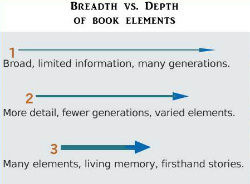The Breadth and Depth of Your Family History: What Gets Into Your Book?
Biff Barnes
Planning a family history book is all about making choices. Having done many years of research and accumulated mountains of information, you may feel a bit overwhelmed when you begin to think about turning it into a book.
One of the first realizations most of us have is that research is nearly infinite (You’ll probably continue to research for the rest of your life.) A book, however, is finite, subject to limitations of both physical size and reader interest. You realize that not everything you have learned about your ancestors will fit in a single volume. The question is, “What gets into the book?”
Matilda Butler, on her excellent blog, Women’s Memoirs, tackled the problem in a post titled Which Do You Have: Big Story or Big Characters? You Can’t Have Both. Her advice to memoirists was:
- If you have a big story–you cover a number of years and/or a number of locations and/or a complicated or convoluted plot–then you need to focus primarily on you and a limited number of other people.
- If on the other hand, your story if fairly straight forward or covers a limited amount of time, you can afford to go deeper into the various people in your story. Let them become rich in details.
The family historian faces much the same decision. You must weigh the breadth of you book against its depth. The further you go back historically the greater the number of ancestors you have to deal with. You have a broad knowledge base. But your information about distant ancestors may not run very deep. Birth, death, marriage, children, and location of their home may be all you have. As you move closer to the present, say three or four generations back, you may begin to have more detailed knowledge about ancestors’ lives. You have deeper stories to tell. When dealing with ancestors whose lives touched people currently living it’s likely that you have a lot of stories about people that were observed directly or have been passed on directly from one generation previous. You probably have more than you can use and must select only the best stories to include.
In making the choice about breadth and depth some family historians chose to include one family line in their book. Others opt to limit the number of generations or set a chronological limit. Some try to blend the two ideas by presenting limited information regarding most ancestors but add extended biographical sketches of those they deem more interesting or important.
What often influences the decision is what information your research has generated. It is critical to take a good inventory of what you have at the outset of the planning stage of your family history book project. That will often answer your question, “What gets into the book?”
